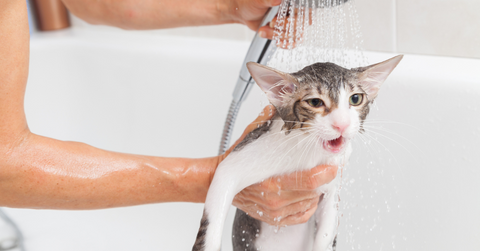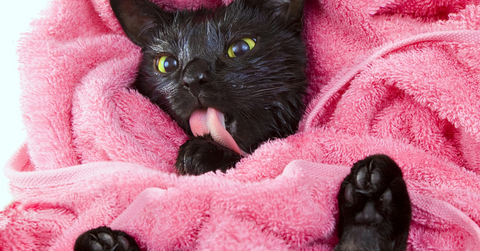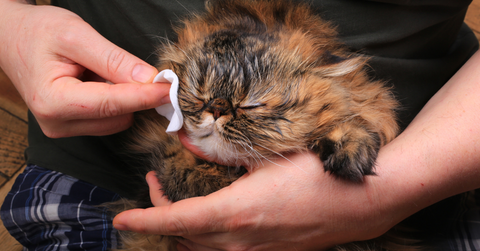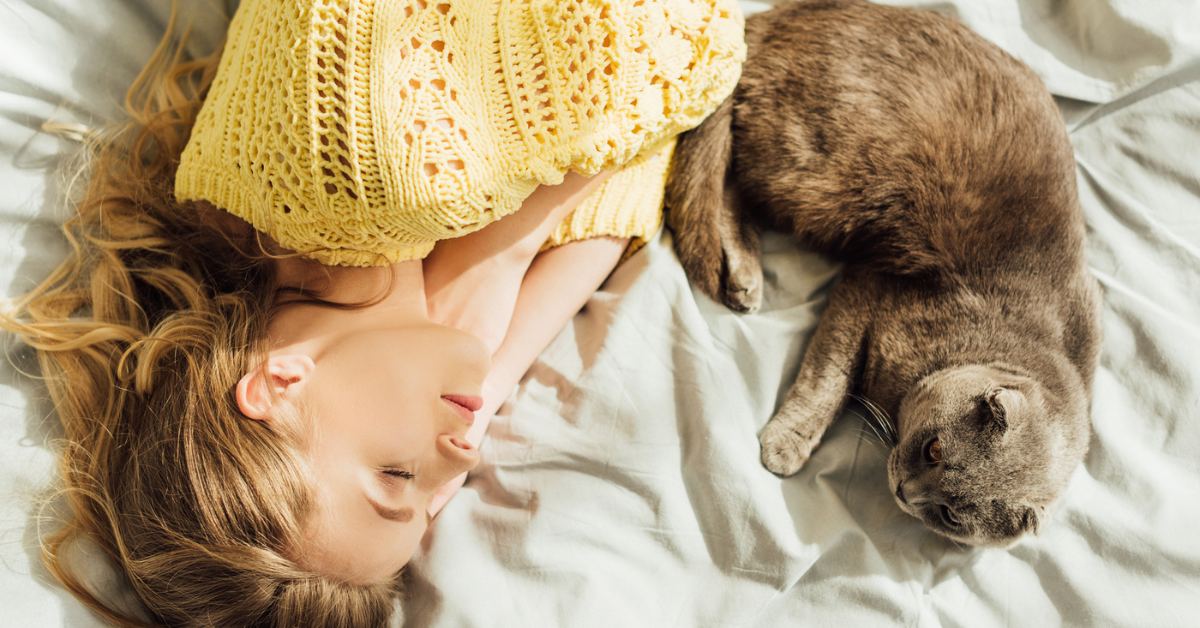Should You Bathe Your Cat? Everything You Need to Know About Cat Hygiene
When it comes to cat hygiene, a common question among cat owners is, "Should you bathe your cat?" Understanding how to care for felines, especially bathing cats properly, is crucial for maintaining their overall health. Most cats are fastidious groomers, but specific scenarios like long-haired cats getting dirty or skin irritations, might require a bath.
With the right cat shampoo and technique, bathing a cat can be less stressful. This blog will guide you through everything from bathing and ear cleaning to nail trimming and dental care. Whether dealing with flaky skin, ear mites, or a dirty kitty, we'll offer these tips for a comfortable, healthy, and happy cat.
Understanding Feline Grooming: Do Cats Self-Clean?
Cats take their grooming habits very seriously. Did you know they dedicate 30-50% of their day to self-grooming? Yes, you read that right! Your cat’s grooming routine is not just about looking good. It’s a complex self-cleaning process to remove scents and maintain coat cleanliness.
Indeed, cats do self-clean, and this behavior is an important part of their daily routine. Here's an overview of why cats groom themselves and the benefits it provides:
- Hygiene: One of the most obvious reasons cats groom themselves is to keep clean. Licking their fur helps remove dirt, debris, and parasites. Their tongues are specially adapted for this purpose, featuring tiny, hook-like structures that act as a natural comb.
- Temperature Regulation: Cats use grooming as a way to regulate body temperature. When it's hot, the saliva they spread on their fur through grooming evaporates, helping them cool down. In colder conditions, grooming helps fluff their fur up, creating better insulation.
- Scent Masking: In the wild, cats groom themselves to remove smells that may attract predators or signal to prey that a predator is near. By keeping themselves clean, they help mask their scent in the environment.
- Comfort and Stress Relief: Grooming releases endorphins in cats, which can help them relax and reduce stress. It's common for a cat to groom itself when feeling anxious or comforted.
- Blood Flow and Skin Health: Grooming stimulates blood flow to the skin, improving skin health. It also helps distribute the natural oils the skin produces along the fur, maintaining a healthy coat.
- Social Bonding: While this point doesn’t directly pertain to self-grooming, it's worth noting that cats also groom each other in a behavior known as allogrooming. This social activity strengthens bonds between cats in the same family or group.
However, excessive grooming can indicate underlying issues such as stress, allergies, skin problems, or parasites. If a cat grooms to the point of hair loss or causes skin irritation, the cat's caregiver should consult a veterinarian to determine the cause and seek appropriate treatment.
Cats are generally very clean animals, and their grooming habits contribute significantly to their health and happiness. While they do an excellent job keeping themselves clean, they still benefit from regular brushing, especially if they have long fur. Occasional baths may be necessary for specific situations or for cats that have gotten into something, particularly messy or sticky.
When Bathing Becomes a Necessity for Most Cats

Bathing a cat may not be the first activity that comes to mind when considering pet care, primarily because many cats hate water. However, several health issues and medical reasons might require bathing your cat more frequently than expected. While many cats do a fantastic job grooming themselves and keeping their fur clean and free of parasites, certain conditions can disrupt this natural process, leading to the need for a helping hand. So, when do these exceptional circumstances arise? Here are several reasons.
1. Fleas and Parasites
One of the most common reasons for bathing a cat is an infestation of fleas or other parasites. These tiny pests can cause severe discomfort and skin irritation, leading to more serious health issues if not addressed promptly. A flea bath, using a cat-safe flea shampoo, can help alleviate this problem, though it should be part of a comprehensive flea treatment plan.
2. Skin Conditions
Cats can suffer from various skin conditions that cause itching, scaling, or skin irritation. Conditions like dermatitis, fungal infections (like ringworm), or allergic reactions to environmental triggers can necessitate bathing with medicated shampoos prescribed by a veterinarian. These shampoos can help soothe the skin, reduce inflammation, and treat the underlying cause of the irritation.
3. Excessive Dirt or Substances
Sometimes, cats get into substances that are harmful or impossible for them to remove through self-grooming. This can include motor oil, sticky foods, or even certain toxic substances. In these cases, bathing is crucial to prevent the cat from ingesting the substance while grooming. Always consult a vet on how to remove these substances, as some may require special handling.
4. Overweight or Arthritic Cats
Many cats, especially as they age, develop arthritis or become overweight, making it difficult to reach all areas of their body during grooming. This can lead to oils, dirt, and dander buildup, potentially causing skin irritation or infections. Bathing these cats can help maintain their skin and coat health, reducing the risk of such complications.
5. Senior Cats or Those with Mobility Issues
Like overweight or arthritic cats, senior cats or those with mobility issues may struggle with self-grooming. Regular, gentle baths can help keep their coat and skin healthy, prevent matting, and reduce the likelihood of skin diseases.
Choosing the Right Cat Shampoo
When bathing your cat, choosing the right cat shampoo is crucial. The shampoo should be:
- Mild
- Unscented
- Free of dyes, soaps, sulfates, and phthalates
- pH-balanced
- Specifically labeled for feline use
Natural Ingredients vs. Harsh Chemicals
When choosing a cat shampoo, look for products that contain natural ingredients such as:
- Chamomile
- Lavender
- Oatmeal
- Vitamin E
These ingredients soothe flaky skin, serve as antiseptics and anti-inflammatories, and can even repel insects.
Organic cat shampoos, which often exclude harmful chemicals, offer a gentler bathing experience and reduce the risk of skin irritation. Remember, your furry friend can suffer from allergies and skin issues caused by artificial fragrances, dyes, and parabens, as well as using products like Dawn dish soap that is not specifically designed for pets.
The Dangers of Using Human Products
You might wonder if you could use your own shampoo on your cat. After all, if it’s good for you, it should be suitable for your pet, right? The answer is a big NO.
Human shampoos can disrupt a cat’s pH balance due to their acidic nature, leading to skin irritation. They often contain toxic ingredients like parabens and sulfates, which can further irritate your cat’s skin and compromise its health.
The Step-by-Step Guide to Bathing Your Cat

So, let’s walk through a step-by-step guide to ensure a successful bath time for your kitty.
Preparing for Bath Time: Creating a Calm Environment
Setting the stage for a positive bath experience starts with creating a calm environment. Here are some steps to follow:
- Allow your cat to explore the bathroom and gradually introduce them to the sound of running water.
- Choose a quiet time for the bath.
- Dim the lights and play soft music to create a soothing atmosphere.
- Maintain a calm demeanor throughout the bath.
Following these steps can help ensure a more positive bath experience for your cat. Remember, patience and a gentle approach go a long way in ensuring a stress-free bath.
Techniques for a Stress-Free Bath
Once your cat is comfortable, it’s time to start the bath. Here’s how:
- Gently wet their fur.
- Apply a cat-specific shampoo, taking care to avoid their eyes and ears.
- Rinse thoroughly to prevent skin irritation.
- Offer praise and treats throughout the process.
After the bath, either towel-dry your cat or, if they stay relaxed, use a hairdryer on the lowest warm setting to help them dry faster.
Post-Bath Care: Drying and Grooming

After the bath, it’s important to quickly dry your cat to ensure its comfort and proper care of its fur. A towel or a damp cloth is all you need to dry your cat. Blot away water without rubbing vigorously, and then, if the cat stays relaxed, gently rub its fur while it’s wrapped in the towel.
Once the initial drying is done, give your cat a good brushing and keep them warm until fully dry.
Towel-Drying vs. Blow-Drying
While blow-drying can be efficient, towel drying is recommended for most cats. After the bath, use towels to dry your cat gently. If your cat is long-haired, carefully wrap it and hold it in the towel to prevent its hair from tangling.
Brushing and Detangling Long Hair
If your cat has long hair, brushing and detangling it after a bath is essential. Frequent brushing is recommended to prevent their fur from tangling and matting.
After bathing, comb out the cat’s fur with a wide-toothed comb. This prevents matting and makes your feline friend look their best.
Additional Hygiene Practices Beyond Bathing
While bathing is an essential part of cat hygiene, it’s not the only grooming practice your cat needs. Additional grooming practices include:
- Nail care
- Cleaning of the inner ears
- Brushing of the fur
- Maintaining dental hygiene
- Ensuring healthy paw pads
Ear Care: Preventing Ear Mites and Keeping Ears Clean

Did you know that your cat’s ears, also known as cat’s ears, require regular attention? Cats can be prone to ear mites and wax build-up, leading to infections and hearing issues. Regular, gentle cleaning of their ears can help prevent these problems. Avoid inserting objects deep into the ear canal to prevent discomfort or damage.
Nail Care: Trimming for Comfort and Safety
If a cat has ever scratched you, you know how sharp their nails can be. Regular nail trimming is essential to maintaining your cat’s paw health, preventing injuries, and protecting your furniture. Aim to trim your cat’s nails every ten days to two weeks as part of their routine care. Remember, proper tools and techniques are crucial to avoid discomfort and injury.
Dental Care: Keeping Kitty's Teeth Clean
When discussing grooming, we often overlook one important aspect - dental care. Regular brushing of your cat’s teeth is crucial to preventing periodontal disease. Dental issues are not always easy to detect, so regular dental check-ups are important.
You can maintain your dental health at home with cat-specific toothbrushes, toothpaste, and even dental treats as part of your cat care routine.
Adapting Hygiene to Your Cat's Needs: Breed and Age Considerations
Every cat is unique, and so are its grooming needs. Depending on your cat’s breed and age, its hygiene routine may require some adaptations. From understanding the specific needs of different breeds to building positive associations with grooming from an early age, let’s explore how we can adapt our grooming practices to our cats' needs.
Specific Needs for Different Cat Breeds
Different cat breeds have different grooming needs. Hairless cats like the Sphinx may need to be bathed as often as every couple of weeks, whereas short-furred breeds may only require bathing once every 4–8 weeks.
For long-haired breeds, especially long-haired cats, frequent brushing and a regular bathing schedule are essential for maintaining their luxurious coats.
Bathing From an Early Age: Building Positive Associations
Starting grooming practices early can go a long way in ensuring a stress-free experience for your cat. Introducing kittens to baths early in their life can lead to a more positive attitude towards the experience as they mature into adulthood. With patience, treats, and a gentle approach, bath time can become a moment of bonding rather than a battle of wits.
Keeping Your Cat Clean with the Best Quality Products
Determining whether you should bathe your cat involves understanding your pet's unique needs and behaviors. Cats are naturally fastidious creatures, often requiring little assistance in maintaining their hygiene. However, a gentle bath might be necessary in certain situations or health issues. Always use cat-specific shampoo to avoid skin problems and minimize stress.
For those looking to provide the best care, Petmate offers top-quality products tailored to all your cat care needs, from grooming to accessories. Ensuring your cat's hygiene is crucial to their overall health, but remember, most cats will thrive with minimal bathing, good brushing, and regular vet check-ups. Shop at Petmate today for quality cat products and embrace a happy, clean, and healthy life for your pet.
Previous article

Next article

Related posts
View all-

5 Simple Tips to Make Sure Your Cat Drinks Enough Water
Ensuring your cat stays hydrated is important, but it can be challenging since many cats don't drink enough water. Dehydration can lead to kidney disease and other health issues. Fortunately, you can encourage your cat to drink more with a few simple changes. Read Article -

How to Keep Your Cat Busy at Night (So You Can Sleep)
For many cat owners, the quest for a good night's sleep while keeping their feline friends content and engaged can seem like a never-ending battle. Cats, naturally more active at night or early in the morning, often disrupt your sleep schedules with nocturnal activity, whether through playful nature or seeking attention. Read Article -

How to Fly with a Large Dog: Tips and Tricks
Traveling can be challenging, especially when it involves flying with a large dog. Whether your furry friend is a service dog, therapy dog, or simply a beloved pet, understanding the guidelines set by most airlines is crucial. Read Article



